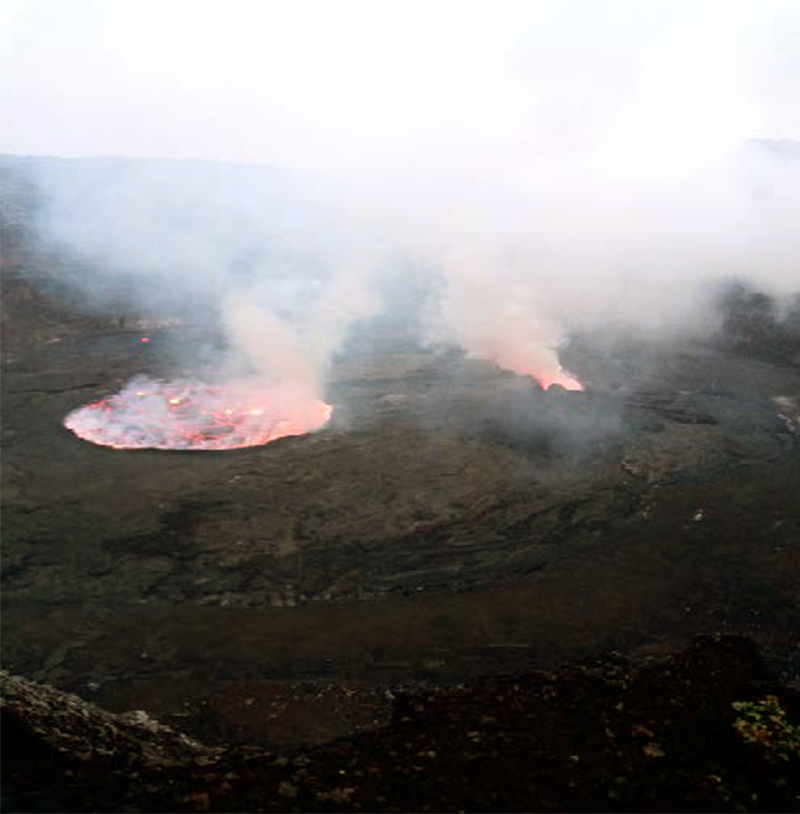Report on Nyiragongo (DR Congo) — June 2020
Bulletin of the Global Volcanism Network, vol. 45, no. 6 (June 2020)
Managing Editor: Edward Venzke.
Edited by Kadie L. Bennis.
Nyiragongo (DR Congo) Activity in the lava lake and small eruptive cone persists during December 2019-May 2020
Please cite this report as:
Global Volcanism Program, 2020. Report on Nyiragongo (DR Congo) (Bennis, K.L., and Venzke, E., eds.). Bulletin of the Global Volcanism Network, 45:6. Smithsonian Institution. https://doi.org/10.5479/si.GVP.BGVN202006-223030
Nyiragongo
DR Congo
1.52°S, 29.25°E; summit elev. 3470 m
All times are local (unless otherwise noted)
Nyiragongo is located in the Virunga Volcanic Province (VVP) in the Democratic Republic of the Congo, part of the western branch of the East African Rift System and contains a 1.2 km-wide summit crater with a lava lake that has been active since at least 1971. Volcanism has been characterized by strong and frequent thermal anomalies, incandescence, gas-and-steam emissions, and seismicity. This report summarizes activity during December 2019 through May 2020 using information from monthly reports by the Observatoire Volcanologique de Goma (OVG) and satellite data.
In the December 2019 monthly report, OVG stated that the level of the lava lake had increased. This level of the lava lake was maintained for the duration of the reporting period, according to later OVG monthly reports. Seismicity increased starting in November 2019 and was detected in the NE part of the crater, but it decreased by mid-April 2020. SO2 emissions increased in January 2020 to roughly 7,000 tons/day but decreased again near the end of the month. OVG reported that SO2 emissions rose again in February to roughly 8,500 tons/day before declining to about 6,000 tons/day. Unlike in the previous report (BGVN 44:12), incandescence was visible during the day in the active lava lake and activity at the small eruptive cone within the 1.2-km-wide summit crater has since increased, consisting of incandescence and some lava fountaining (figure 72). A field survey was conducted on 3-4 March where an OVG team observed active lava fountains and ejecta that produced Pele’s hair from the small eruptive cone (figure 73). During this survey, OVG reported that the level of the lava lake had reached the second terrace, which was formed on 17 January 2002 and represents remnants of the lava lake at different eruption stages. There, the open surface lava lake was observed; gas-and-steam emissions accompanied both the active lava lake and the small eruptive cone (figures 72 and 73).
MIROVA (Middle InfraRed Observation of Volcanic Activity) analysis of MODIS satellite data continued to show frequent strong thermal anomalies within 5 km of the summit crater through May 2020 (figure 74). Similarly, the MODVOLC algorithm reported multiple thermal hotspots almost daily within the summit crater between December 2019 and May 2020. These thermal signatures were also observed in Sentinel-2 thermal satellite imagery within the summit crater (figure 75).
 |
Figure 74. Thermal anomalies at Nyiragongo from 27 July through May 2020 as recorded by the MIROVA system (Log Radiative Power) were frequent and strong. Courtesy of MIROVA. |
Geological Summary. The Nyiragongo stratovolcano contained a lava lake in its deep summit crater that was active for half a century before draining catastrophically through its outer flanks in 1977. The steep slopes contrast to the low profile of its neighboring shield volcano, Nyamuragira. Benches in the steep-walled, 1.2-km-wide summit crater mark levels of former lava lakes, which have been observed since the late-19th century. Two older stratovolcanoes, Baruta and Shaheru, are partially overlapped by Nyiragongo on the north and south. About 100 cones are located primarily along radial fissures south of Shaheru, east of the summit, and along a NE-SW zone extending as far as Lake Kivu. Many cones are buried by voluminous lava flows that extend long distances down the flanks, which is characterized by the eruption of foiditic rocks. The extremely fluid 1977 lava flows caused many fatalities, as did lava flows that inundated portions of the major city of Goma in January 2002.
Information Contacts: Observatoire Volcanologique de Goma (OVG), Departement de Geophysique, Centre de Recherche en Sciences Naturelles, Lwiro, D.S. Bukavu, DR Congo; MIROVA (Middle InfraRed Observation of Volcanic Activity), a collaborative project between the Universities of Turin and Florence (Italy) supported by the Centre for Volcanic Risk of the Italian Civil Protection Department (URL: http://www.mirovaweb.it/); Hawai'i Institute of Geophysics and Planetology (HIGP) - MODVOLC Thermal Alerts System, School of Ocean and Earth Science and Technology (SOEST), Univ. of Hawai'i, 2525 Correa Road, Honolulu, HI 96822, USA (URL: http://modis.higp.hawaii.edu/); Sentinel Hub Playground (URL: https://www.sentinel-hub.com/explore/sentinel-playground).




